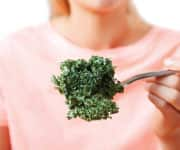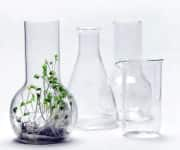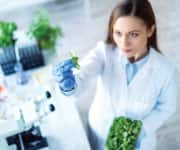Life Extension Magazine®
As the “war on cancer” drags on, the National Cancer Institute estimates that 1.7 million Americans were diagnosed with cancer last year.1
Doesn’t sound like much progress has been made since the “war” was declared by the U.S. government in 1971.
But there is hope that lies in prevention. Scientists agree that preventing cancer is the best strategy.
As many as 90% of all cancers are caused by environmental factors and lifestyle behaviors.2,3
Ongoing research points to anti-cancer effects of compounds found in broccoli and other cruciferous vegetables.
Studies show that higher intake of cruciferous vegetables is associated with a reduced risk for different types of cancers.4,5
But to maximize the effects of these cancer-fighting compounds, you’d have to consume an enormous quantity of raw vegetables.
Scientists have discovered a way to remedy this problem. They have developed a delivery system to maximize the amounts of cancer-fighting compounds in cruciferous vegetables that enter the bloodstream.
Chemistry of Cruciferous Vegetables

Cruciferous vegetables are a group of edible plants that include broccoli, kale, green and red cabbage, cauliflower, and Brussels sprouts.
These vegetables are loaded with nutrients shown to help prevent a wide variety of common disorders.
In particular, cruciferous vegetables have a profound ability to shield cells from several processes that can transform healthy cells into malignant tumors.4,5
Two cruciferous nutrients are especially well validated: sulforaphane and 3,3’-diindolylmethane (DIM). The benefits of both are supported by ample medical literature.6-8
DIM is a stable compound that is readily absorbed from the digestive system.
Sulforaphane, however, is very unstable, which means it rapidly degrades into non-active substances if it isn’t quickly absorbed, or if the vegetable is heavily cooked.
Nature has found a way around this problem.
How Plants Make Sulforaphane

Sulforaphane itself isn’t contained in broccoli and cabbage.
Instead, a precursor called glucoraphanin is stored in these plant cells, along with an enzyme, myrosinase, that converts the glucoraphanin into sulforaphane.
In raw vegetables, glucoraphanin and myrosinase are stored in separate compartments.
Only when the vegetables have been eaten and partially digested do they mix in the body and form sulforaphane, the beneficial compound.
Once formed, sulforaphane must be absorbed rapidly in the small intestine or it will be lost.
A Solution Inspired by Nature
Scientists have found a way to deliver both glucoraphanin and myrosinase, isolated from broccoli, separately to the small intestine.
In the small intestine, these two components mix and form sulforaphane, which can be immediately absorbed into the body, achieving higher blood levels of this anti-cancer compound.
In a study done by scientists at Johns Hopkins, healthy individuals were given either glucoraphanin alone or in combination with the enzyme myrosinase. Urinary metabolites of sulforaphane were used to assess bioavailability.
The bioavailability of the combination of glucoraphanin and myrosinase was 35% compared to 10% in the group given only glucoraphanin.9
Sulforaphane and DIM Research

For decades, studies have shown that large dietary intakes of cruciferous vegetables reduce the risk of developing different forms of cancer, including many of the most common types, such as lung and colorectal cancer.5,10,11
Researchers have also evaluated the individual compounds derived from these vegetables, most importantly sulforaphane and DIM.
Scientists at the Johns Hopkins University School of Medicine compared two different groups of rats; one was given sulforaphane and one was not.12 Both groups were then given a potent carcinogen, a chemical that produces cancerous tumors at a high rate. They found that the animals given sulforaphane developed 39% fewer tumors. In addition, the tumors that did develop were smaller and grew more slowly.
In human cancer cell lines, including breast cancer and leukemia, sulforaphane was shown to halt the growth of the tumors and to kill tumor cells.8
The benefit of DIM supplementation has been evaluated in two studies of women with a history of breast cancer.13,14 In both studies, women were randomized to receive DIM supplementation (108 mg per day in one, 300 mg per day in the other) or a placebo. DIM was found to significantly alter the mix of estrogen types, supporting an increase in “good” estrogen and reducing “bad” estrogen, which is linked to cancer progression.
DIM has also been evaluated in women for prevention of cervical cancer.6,10 Cervical intraepithelial neoplasia is a cervical cancer precursor.
In one study, women with cervical intraepithelial neoplasia were randomized to receive either 100 mg of DIM, 200 mg of DIM, or a placebo. After 90 to 180 days of supplementation researchers found that all patients’ cervical intraepithelial neoplasia resolved completely with the 200 mg dose of DIM. With the lower 100 mg dose of DIM, 90.5% regressed.6
What this shows is that these compounds, derived from cruciferous vegetables, can both prevent cancer and reverse the progression of cells that are already abnormal.
What you need to know
- Cruciferous vegetables, including broccoli, cabbage, cauliflower, Brussels sprouts, and kale, are associated with reduced risk of cancer and other age-related diseases.
- Two compounds derived from these vegetables, sulforaphane and DIM, are responsible for most of this anti-cancer activity.
- Large amounts of raw vegetables would need to be consumed to maximize these effects.
- Unlike DIM, sulforaphane is unstable and rapidly degrades if not absorbed quickly.
- Scientists have found a way to deliver glucoraphanin and myrosinase to the intestine to achieve higher levels of the anti-cancer compound sulforaphane.
Four Ways Cruciferous Vegetables Protect Against Cancer

Cancer results from damage to genes that causes cells to multiply out of control.
Toxins and pollutants in the air we breathe, the water we drink, and the food we eat can all cause this damage. Even our own metabolism produces oxidative stress and potential toxins.
Behavior such as smoking greatly increases the amount of damage that is occurring.
Methods to decrease cancer risk include:
- Protecting DNA genes from mutations (damage)
- Reducing inflammation
- Impairing ability of abnormal cells to propagate
Compounds found in cruciferous vegetables act in four major ways to prevent cancer.
1. Protecting against Epigenetic Changes
Cancer can be caused by epigenetic changes, the ability to “turn genes on and off.” These changes don’t alter the DNA, but they change expression patterns of genes.
Studies have shown that sulforaphane and DIM can reverse some of these cancer-associated alterations.15
Sulforaphane also reverses alterations of histone proteins involved in the regulation of genes, another epigenetic change that can contribute to cancer.16,17
2. Attacking Cancer Cells
Even after a cell starts down the path to cancer, the progression can be halted or reversed.
DIM and sulforaphane have been shown to suppress the growth of tumors by interfering with abnormal signaling factors that drive cancer cells to proliferate more rapidly.12
DIM also slows the propagation of tumor cells by blocking abnormal angiogenesis, the growth of new blood vessels.18
Cancers need ample blood flow to supply oxygen and nutrients so that they can grow aggressively. By impeding this new blood vessel growth, cruciferous vegetables can help starve tumor cells.
DIM and sulforaphane also directly kill cancer cells through the process of apoptosis, programmed cell death.19,20
By turning on the genes associated with apoptosis, cruciferous vegetables initiate “suicide” of the abnormal cells, while protecting healthy, normal cells.
3. Modulating Sex Hormones
Some forms of the hormone estrogen can stimulate breast cancer growth in women. By modulating estrogen metabolism, DIM shifts estrogen balance to favor the healthier forms of these hormones.21
In aging men, estrogen balance is also critical. Our early observations revealed that men presenting with benign prostate enlargement or prostate cancer had higher blood estrogen levels.22,23 Subsequent clinical and laboratory studies helped confirm our early observations.24-28 DIM can prevent stimulation of prostate cancer cells by estrogen.29,30
4. Inhibiting NF-kB
NF-kB (nuclear factor-kappa B) is a regulator in cells that activates inflammation, including the low-grade chronic inflammation that is a major contributor to most age-related diseases, including cancer.
Sulforaphane blocks NF-kB, thereby reducing inflammation that contributes to cancer growth.31
By reducing NF-kB activity, sulforaphane also has a powerful impact on other chronic diseases, and aging in general. For example, in animal models it can reduce inflammation in the brain that contributes to Alzheimer’s and Parkinson’s diseases.32,33
Summary
High dietary intake of raw cruciferous vegetables such as broccoli, cabbage, and cauliflower, is associated with a reduced risk for many types of cancer and other disorders.
Studies have demonstrated that many of the anti-cancer effects are due to two compounds derived from these vegetables: sulforaphane and DIM.
These cruciferous compounds target cancer at different points in its development and progression, reducing the risk of cancer formation in the first place, and halting the progression of some tumor cells.
While DIM is stable and easily absorbed when taken orally, sulforaphane is rapidly converted to inactive compounds.
To solve this problem, scientists have developed a delivery system (glucoraphanin plus myrosinase) that maximizes the amount of sulforaphane available for absorption into the bloodstream.
By separating these precursor plant compounds, much more sulforaphane becomes bioavailable in the small intestine. There, it can be rapidly absorbed, delivering higher blood levels of this anti-cancer (sulforaphane) compound.
If you have any questions on the scientific content of this article, please call a Life Extension® Wellness Specialist at 1-866-864-3027.
References
- Available at: https://www.cancer.gov/about-cancer/understanding/statistics. Accessed June 7, 2019.
- Anand P, Kunnumakkara AB, Sundaram C, et al. Cancer is a preventable disease that requires major lifestyle changes. Pharm Res. 2008 Sep;25(9):2097-116.
- Wu S, Powers S, Zhu W, et al. Substantial contribution of extrinsic risk factors to cancer development. Nature. 2016 Jan 7;529(7584):43-7.
- Dinkova-Kostova AT, Fahey JW, Kostov RV, et al. KEAP1 and Done? Targeting the NRF2 Pathway with Sulforaphane. Trends Food Sci Technol. 2017 Nov;69(Pt B):257-69.
- Verhoeven DT, Goldbohm RA, van Poppel G, et al. Epidemiological studies on brassica vegetables and cancer risk. Cancer Epidemiol Biomarkers Prev. 1996 Sep;5(9):733-48.
- Ashrafian L, Sukhikh G, Kiselev V, et al. Double-blind randomized placebo-controlled multicenter clinical trial (phase IIa) on diindolylmethane’s efficacy and safety in the treatment of CIN: implications for cervical cancer prevention. EPMA J. 2015;6:25.
- Kyung SY, Kim DY, Yoon JY, et al. Sulforaphane attenuates pulmonary fibrosis by inhibiting the epithelial-mesenchymal transition. BMC Pharmacol Toxicol. 2018 Apr 2;19(1):13.
- Su X, Jiang X, Meng L, et al. Anticancer Activity of Sulforaphane: The Epigenetic Mechanisms and the Nrf2 Signaling Pathway. Oxid Med Cell Longev. 2018;2018:5438179.
- Fahey JW, Holtzclaw WD, Wehage SL, et al. Sulforaphane Bioavailability from Glucoraphanin-Rich Broccoli: Control by Active Endogenous Myrosinase. PLoS One. 2015;10(11):e0140963.
- Higdon JV, Delage B, Williams DE, et al. Cruciferous vegetables and human cancer risk: epidemiologic evidence and mechanistic basis. Pharmacol Res. 2007 Mar;55(3):224-36.
- Tang L, Zirpoli GR, Jayaprakash V, et al. Cruciferous vegetable intake is inversely associated with lung cancer risk among smokers: a case-control study. BMC Cancer. 2010 Apr 27;10:162.
- Zhang Y, Kensler TW, Cho CG, et al. Anticarcinogenic activities of sulforaphane and structurally related synthetic norbornyl isothiocyanates. Proc Natl Acad Sci U S A. 1994 Apr 12;91(8):3147-50.
- Thomson CA, Chow HHS, Wertheim BC, et al. A randomized, placebo-controlled trial of diindolylmethane for breast cancer biomarker modulation in patients taking tamoxifen. Breast Cancer Res Treat. 2017 Aug;165(1):97-107.
- Dalessandri KM, Firestone GL, Fitch MD, et al. Pilot study: effect of 3,3’-diindolylmethane supplements on urinary hormone metabolites in postmenopausal women with a history of early-stage breast cancer. Nutr Cancer. 2004;50(2):161-7.
- Wong CP, Hsu A, Buchanan A, et al. Effects of sulforaphane and 3,3’-diindolylmethane on genome-wide promoter methylation in normal prostate epithelial cells and prostate cancer cells. PLoS One. 2014;9(1):e86787.
- Tortorella SM, Royce SG, Licciardi PV, et al. Dietary Sulforaphane in Cancer Chemoprevention: The Role of Epigenetic Regulation and HDAC Inhibition. Antioxid Redox Signal. 2015 Jun 1;22(16):1382-424.
- Bayat Mokhtari R, Baluch N, Homayouni TS, et al. The role of Sulforaphane in cancer chemoprevention and health benefits: a mini-review. J Cell Commun Signal. 2018 Mar;12(1):91-101.
- Chinnakannu K, Chen D, Li Y, et al. Cell cycle-dependent effects of 3,3’-diindolylmethane on proliferation and apoptosis of prostate cancer cells. J Cell Physiol. 2009 Apr;219(1):94-9.
- Pledgie-Tracy A, Sobolewski MD, Davidson NE. Sulforaphane induces cell type-specific apoptosis in human breast cancer cell lines. Mol Cancer Ther. 2007 Mar;6(3):1013-21.
- Kim SM. Cellular and Molecular Mechanisms of 3,3’-Diindolylmethane in Gastrointestinal Cancer. Int J Mol Sci. 2016 Jul 19;17(7).
- Thomson CA, Ho E, Strom MB. Chemopreventive properties of 3,3’-diindolylmethane in breast cancer: evidence from experimental and human studies. Nutr Rev. 2016 Jul;74(7):432-43.
- Gann PH, Hennekens CH, Stampfer MJ. A prospective evaluation of plasma prostate-specific antigen for detection of prostatic cancer. Jama. 1995 Jan 25;273(4):289-94.
- Krieg M, Nass R, Tunn S. Effect of aging on endogenous level of 5 alpha-dihydrotestosterone, testosterone, estradiol, and estrone in epithelium and stroma of normal and hyperplastic human prostate. J Clin Endocrinol Metab. 1993 Aug;77(2):375-81.
- Giton F, de la Taille A, Allory Y, et al. Estrone sulfate (E1S), a prognosis marker for tumor aggressiveness in prostate cancer (PCa). J Steroid Biochem Mol Biol. 2008 Mar;109(1-2):158-67.
- Prins GS, Korach KS. The role of estrogens and estrogen receptors in normal prostate growth and disease. Steroids. 2008 Mar;73(3):233-44.
- Singh PB, Matanhelia SS, Martin FL. A potential paradox in prostate adenocarcinoma progression: oestrogen as the initiating driver. Eur J Cancer. 2008 May;44(7):928-36.
- Ho CK, Nanda J, Chapman KE, et al. Oestrogen and benign prostatic hyperplasia: effects on stromal cell proliferation and local formation from androgen. J Endocrinol. 2008 Jun;197(3):483-91.
- Matsuda T, Abe H, Suda K. [Relation between benign prostatic hyperplasia and obesity and estrogen]. Rinsho Byori. 2004 Apr;52(4):291-4.
- Smith S, Sepkovic D, Bradlow HL, et al. 3,3’-Diindolylmethane and genistein decrease the adverse effects of estrogen in LNCaP and PC-3 prostate cancer cells. J Nutr. 2008 Dec;138(12):2379-85.
- Chen D, Banerjee S, Cui QC, et al. Activation of AMP-activated protein kinase by 3,3’-Diindolylmethane (DIM) is associated with human prostate cancer cell death in vitro and in vivo. PLoS One. 2012;7(10):e47186.
- Sturm C, Wagner AE. Brassica-Derived Plant Bioactives as Modulators of Chemopreventive and Inflammatory Signaling Pathways. Int J Mol Sci. 2017 Sep 1;18(9).
- Hernandez-Rabaza V, Cabrera-Pastor A, Taoro-Gonzalez L, et al. Neuroinflammation increases GABAergic tone and impairs cognitive and motor function in hyperammonemia by increasing GAT-3 membrane expression. Reversal by sulforaphane by promoting M2 polarization of microglia. J Neuroinflammation. 2016 Apr 18;13(1):83.
- Subedi L, Cho K, Park YU, et al. Sulforaphane-Enriched Broccoli Sprouts Pretreated by Pulsed Electric Fields Reduces Neuroinflammation and Ameliorates Scopolamine-Induced Amnesia in Mouse Brain through Its Antioxidant Ability via Nrf2-HO-1 Activation. Oxid Med Cell Longev. 2019;2019:3549274.

